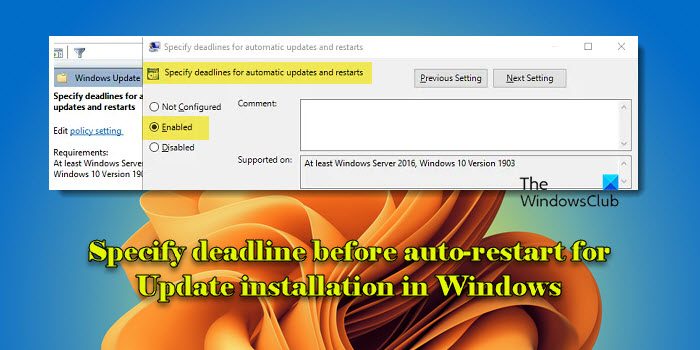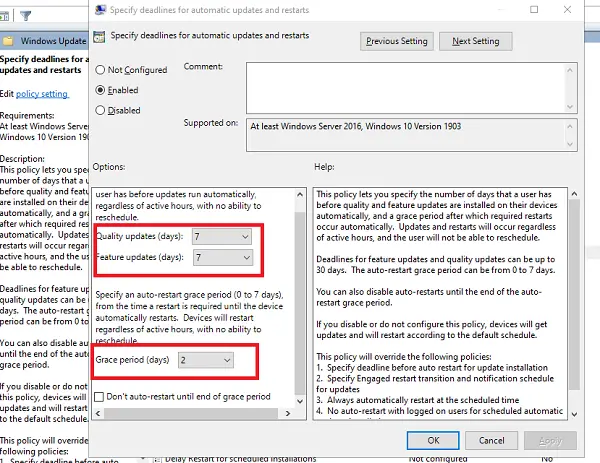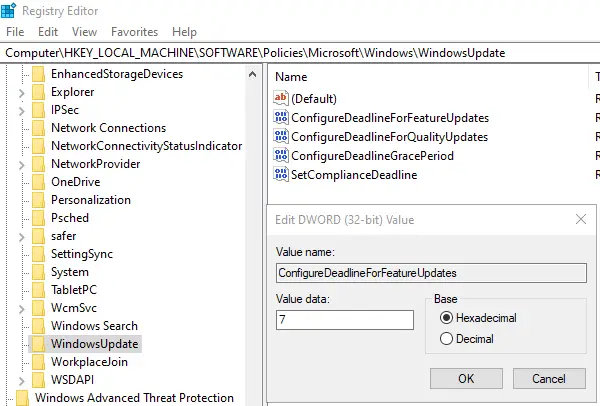On Windows 11/10, Microsoft has rolled out a setting that notifies you after downloading a feature update. In the end, you have a choice when to install the update, but there is a limit to that. It is now possible to specify the deadline before auto-restart for update installation. In this post, we will learn about it.

Specify deadline before auto-restart for update installation
Setting up these means you can now specify when Windows 11/10 updates should run automatically, and when the PC should restart to apply the changes. The deadline means that after crossing, the Windows Update system will automatically execute a pending restart regardless of active hours. You can do this using the following two methods:
- Group Policy
- Registry Editor.
Before changing Registry entries, make sure to create a restore point. In case you end up doing something that causes a problem on the computer, you can always restore it to a previous working state.
1] Specify deadline using Group Policy Editor

- Open Group Policy Editor
- Navigate to Computer Configuration > Administrative Templates > Windows Components > Windows Update.
- Open a policy with name Specify the deadline before auto-restart for update installation, and enable it.
When you enable it, you have to configure the number of days for Quality Updates and Feature Updates before the automatic restart kicks in. The number of days can be set between 2 to 30.
There is an additional setting — Grace Period. When you specify a grace period, it will override the specified deadline before auto-restart for update installation. When the grace period is over, the computer will restart regardless of active hours with no ability to schedule.
It’s a good idea to use the Grace Period (0 to 7 days) which gives the end-users a sort of warning that their time is running out and it’s better to update.
Lastly, you should know that the below-mentioned policies will override the policy we mentioned above.
- Specify deadline before auto-restart for update installation
- Specify Engaged restart transition and notification schedule for updates
- Always automatically restart at the scheduled time
- No auto-restart with logged on users for scheduled automatic updates installation
2] Specify deadline using Registry Editor

There is a reason why I have explained so many things in the Group Policy section. When you enable the policy, it creates registry entries. You can change the value of these to achieve the same configuration.
So, if you want to do the same using Registry Editor, follow these steps:
- Open Registry Editor
- Navigate to
HKEY_LOCAL_MACHINE\SOFTWARE\Policies\Microsoft\Windows\
- Right-click on Windows, create a new Key or Folder, and name it WindowsUpdate
- Then create these DWORDS
- ConfigureDeadlineForFeatureUpdates
- ConfigureDeadlineForQualityUpdates
- ConfigureDeadlineGracePeriod
- SetComplianceDeadline
- Enter a value between 2 to 30 (0 to 7 for Grace Perio) after you choose the Decimal radio button.
We hope the steps were easy to follow, and that you were able to specify the deadline before auto-restart for update installation using Group Policy or Registry Editor.
Read: Specify Engaged restart transition and notification schedule for Updates.
How do I schedule Windows Update to install automatically?
By default, Windows automatically checks for updates and downloads them in the background without user intervention. This includes security updates, feature updates, and driver updates. This ensures that the system receives critical updates as soon as they become available. To minimize disruption, Windows installs updates during periods of low activity or outside active hours, as configured by the user. If a restart is required to finish the update installation, Windows attempts to schedule it during inactive hours, or it may prompt the user to set a convenient time for the restart.
How do I stop Windows Update before restarting?
You may use the Pause updates option if you want to stop Windows from restarting to apply updates, especially if you’re in the middle of something important or need more time before the system restarts. When updates are paused, Windows does not download new updates or install any pending updates until the pause period (up to 35 days) expires or until you manually resume updates. If Windows is already preparing to restart to apply updates, you can cancel or delay the restart by executing the shutdown /a command in the Command Prompt or by disabling the Windows Update service.
Read Next: Windows Update fails to install or will not download in Windows.